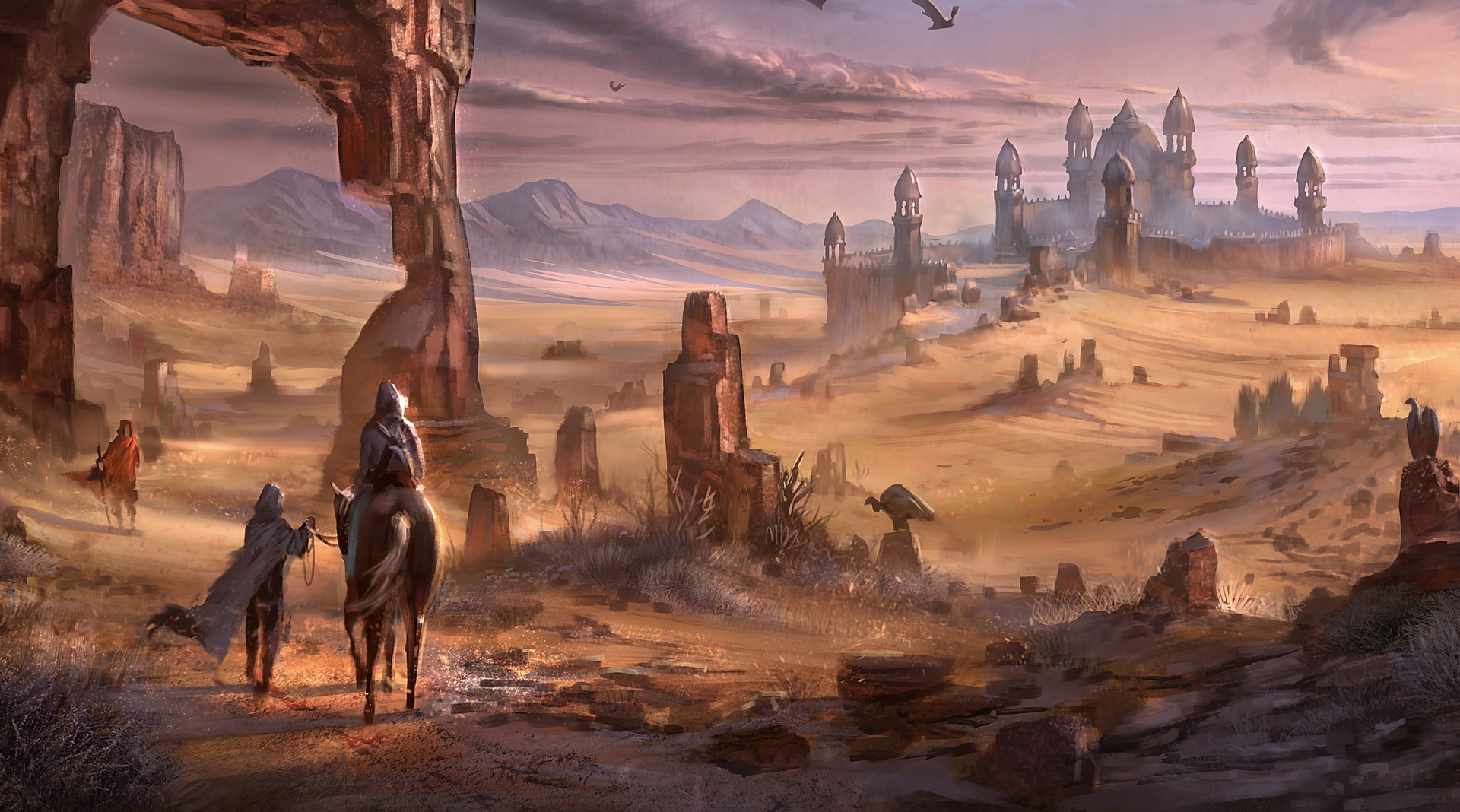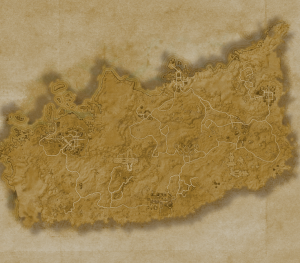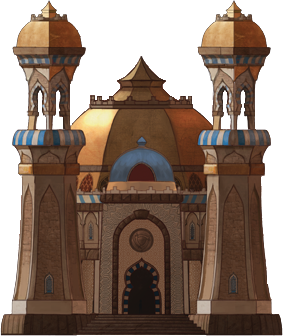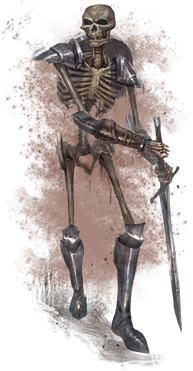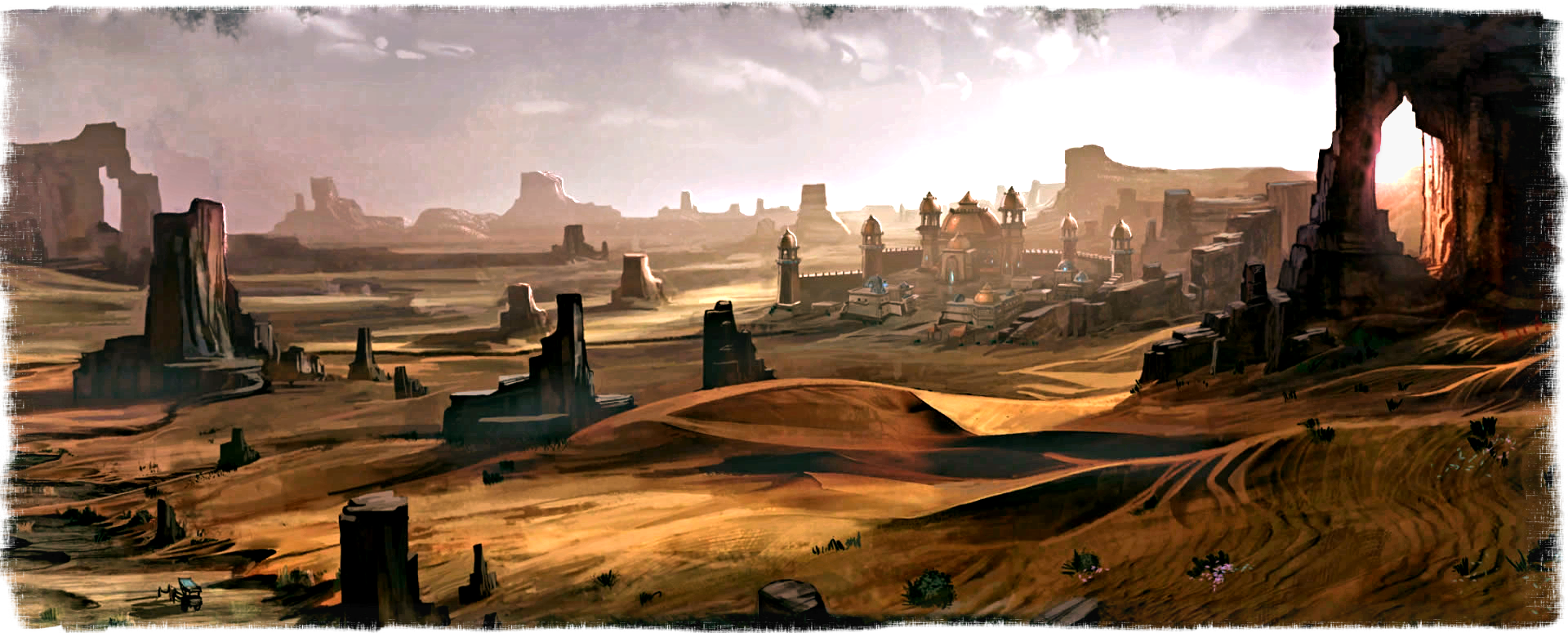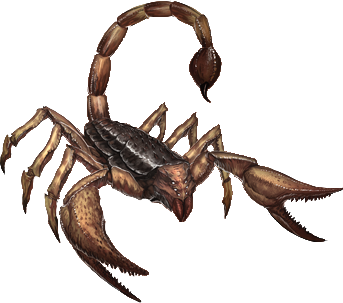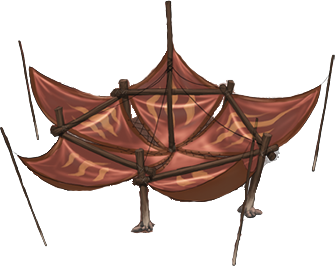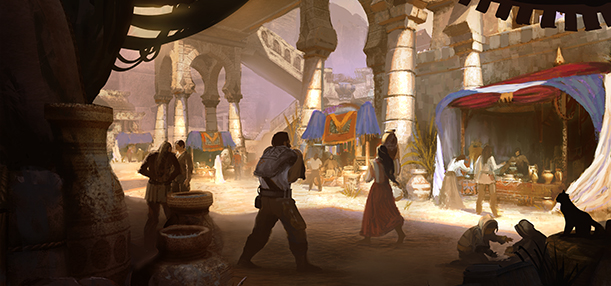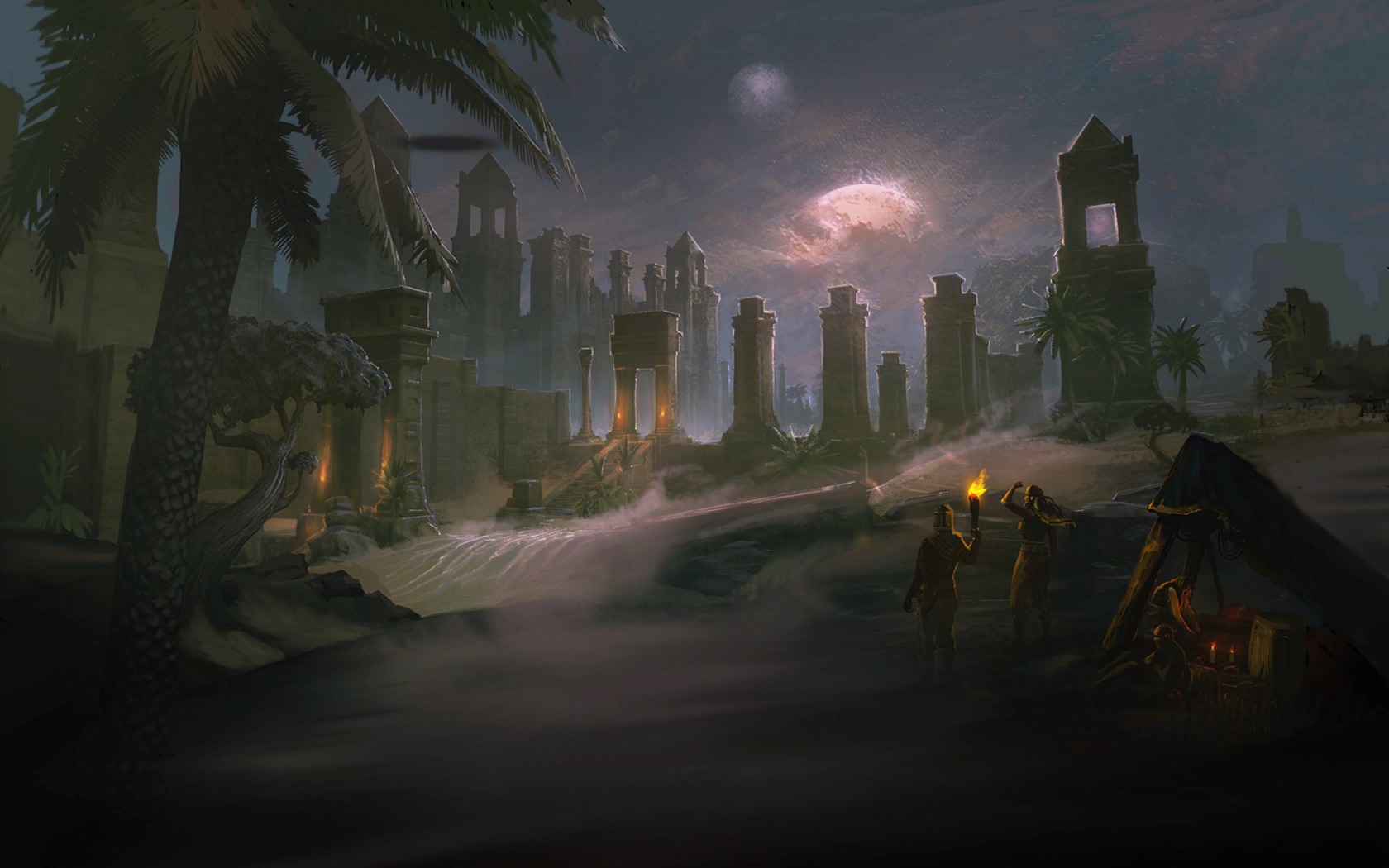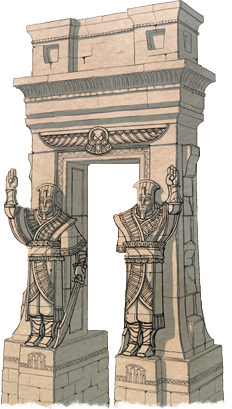Original media : The Elder Scrolls Online Imperial Edition
By Flaccus Terentius, of the Imperial Geographic Society, 2E 581
HAMMERFELL
Redguards of the Daggerfall Covenant
The sea crossing of Iliac Bay gave me a chance to read up on Yokudan history. Violence, hubris, and cunning seem to be recurring themes here.
T he arid wasteland west of Colovia and south of Iliac Bay was an abandoned realm. During the First Era, the Aldmer referred to this desolate places as "Hegathe" and the Nedic people called it "Deathland." Stifling, sandy winds clogged explorers' lungs, while baking rocks branded their feet. The only footprints to be discovered were made with the scaly hooves or claws of terrible monsters that stalked this land. So it is to the credit of the Redguards that their banishment to these shores paid dividends, and their adept adaptation to this new homeland resulted in a powerful province and a new mandate. This is Deathland no longer: This is Hammerfell.
During the First Era, the city of Sentinel was a simple outpost, a show of force and protection against Orc marauders, Goblin raiders, roaming trolls, cattle-sized scorpions, and other more terrifying spirits that dared enter High Rock. But the Redguards were not the first to settle this desert; a Dwemer faction known as the Rourken disagreed with the Chimer and Dwemer alliances in Morrowind and moved into the Deathlands, trading with the southern Elves and northern Bretons alike. They sanctified their capital as Volenfell, or "City of the Hammer." Despite their attempts to distance themselves from the War of the First Council, they paid the price of all Dwemer, and the Rourken disappeared. Almost overnight, the Dwemer capital was among Deathland's empty cities. Only ghosts and creatures from the inland desert roamed the old alleyways and empty buildings, interrupted by the looting of Abecean and Nord pirates. To this day, Volenfell lies buried and silent under the Alik'r's boiling sands.
|
 As I haven't been chased or abducted, and the only embarrassment I'm causing is the seasick vomiting of half-digested horse meat into the Iliac Bay, I'm claiming my first real contact with the Redguards as tantamount to a success. Aboard the Sentinel-bound ship, I'm immediately struck by how martial this culture is. From the captain to the rigging boy, all wear their weapons constantly. The marines who guard this vessel are even dressed in heavy armor!
What if they fell overboard?
Compared to the temperamental Bretons, the Redguard race seems positively dignified. Standing broad-shouldered and tall, with dark skin and wiry hair, they are seemingly born with a sword in their hand. I spoke with a few of them and found them formal, obsessed with personal honor, and quite aloof. While Breton culture had felt almost familiar to an Imperial like me, seeing the glinting domes of the city-port of Sentinel on the horizon gave me no such comfort. The Redguards were people from another continent, and it seemed they'd brought as much of Yokuda to Tamriel as they could manage.
L ike a swarm of slaughterfish, the Ra Gada armada tore along Tamriel's shores as the Yokudan invasion began. Furious fighters with nothing to lose - their own archipelago was lost to the western seas - they brought swift death to coastal colonies of unprepared Breton and rampageous Orc folk. No compromises were made. The province of Hammerfell and the Na-Totambu government of the Yokuda -- who became known as the Redguards -- thrived. Customary farming practices and religions flourished, even in the arid climate. These swift victories and the quick construction of Sentinel, with its numerous high-domed structures (resplendent with mosaic adumbrations) on the shore of the deep desert, startled Elf and Man alike. While the Bretons nursed their wounds and pride, the Redguards defied their hard desert surroundings. It took more than 100 years and the rise of Orsinium for the Bretons to suppress the Redguards' violent arrogance; this galvanized an uneasy truce and began economic relations.
Time heals even the deepest wounds. The recent Daggerfall Covenant is holding, and although outer regions of Hammerfell remain distrusting, the city-states of Sentinel and Hallin's Stand are committed to fight with King Emeric of Cumberland. The social hierarchy of Sentinel (the Forebears) is well versed in diplomacy with High Rock. But standing shoulder to shoulder with the Orcs tests the Redguards' commitment and honor to the snapping point. So far, both factions have kept their word (although interracial tasks are undertaken with gritted teeth and stringent overseeing). Although the Redguards are fewest in number, the Covenant seems obliged to prosper from their influence, from the tactical expansionism of the Forebear king Fahara'jad to the calculated war-planning of his generals and maritime adeptness of this sailors.
Fahara'jad may have more than simple alliances in mind. His daughter is married to King Emeric. He garnered support and played upon religious fervor after a starry comet skirted the northern heavens, and Fahara'jad believed it was a sign from HoonDing, the Yokudan Make Way God. A ruler with such guile must either be befriended or utterly crushed.
|
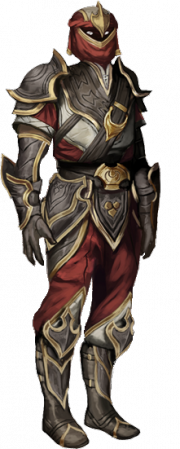 When the ship's guards aren't talking about the veneration of some chap called "Frandar" and his "Way of the Sword," they're practicing thrusts, cuts, and parrying with their swords. Or they're sharing advice on the care and polish of their swords: I sense a pattern emerging. While the Redguard soldier carries a variety of other killing implements -- which I sketched between bouts of seasickness -- a marine named Wisr-al-Maeen explained that a Redguard's sword is an extension of his soul and a symbol of honor. Their consorts have more care for their blades than a Nord does for his mead.
T he history of the sword-saint, or "Ansei," tradition can be traced back to the time of Lord Frandar Hunding, the first warrior prince. Previously, civil war had run rampant across Yokuda. Those married to the arts of poetry and learning were forced to join their uncouth brothers and sisters, and all were to learn the song of the blade. When the commoner Randic Torn tried to unify the Yokudan Empire, he decreed that only warriors -- known as sword-singers -- could carry such weapons.
Frandar's ilk were artisans who valued beauty in the smithing of magnificent blades tempered with magic. But even more intense devotion to the gods of war allowed them to use their minds to conjure swords of insubstantial light. Those Ansei with otherworldly piety took this further, changing light into substantial, bone-cleaving reality. Disarming such an Ansei now required severing their head. Hunding's Shehai slew entities both wondrous and monstrous. After the defeat of Lord Janic and his seven lich guardians, Hunding retreated to the Hattu Mountains. Now invincible, he spent the next 30 years crafting his learnings into the Book of Circles. As Hunding readied for death, his hermitage was finally interrupted when his people called upon him.
A new and final emperor was crowned: Hira. His thirst for power could be quenched only by wrenching control from the people and slaying all the sword-singers. And the Singers prevailed. Hira's empire was routed and scattered after seven terrible battles, but the commoners with little regard for the Way cared not about the reasons for their own salvation. So the Singers set sail across a vast ocean, vowing to honor their past but adopt a new name: Redguard. Now, every household in the province has an alcove above the hearth: a place where Hunding is honored and the Book of Circles is cherished.
Superstitious nonsense. "Swords of light?" Please.
|
F ahara'jad inherited a kingdom of uncertainty. His predecessor King Ramzi the Distrait was a self-serving and weak-willed ruler, failing utterly to protect his subjects as man and child succumbed to the Knahaten Flu. Ramzi regarded the plague as divine punishment from Ruptga for his personal failings. As the creeping death spread to his courtiers, Ramzi sealed himself within the palace and slowly starved to death, so great was his fear of contracting the virus. As the Flu turned the realm to chaos, Forebear noble Fahara'jad took command of Sentinel's throne.
Hushed whispers spoke of a plot by the Forebears. Sentinel's citizens grew paranoid. The absence of a firm ruler proved almost cataclysmic for the once-prosperous settlement, until the brash young Fahara'jad completed his journey from Bergama, stepped into Sentinel, and declared himself king. The rulers of the southern provinces acted with vehement repudiation, but the Forebear viziers and northern chieftains ratified the action. Perhaps sensing an uprising from the south, Fahara'jad proved himself most cunning, allying himself with the Daggerfall Covenant to pronounce himself High King of all Hammerfell. Seething silence from the south boiled over into vexation at the sheer effrontery, but the foes of Fahara'jad found his claims too difficult to challenge.
Many considered Fahara'jad to be a usurper, a false ruler waiting for comeuppance at the many hands of the god Satakal the Worldskin. But being thrice blessed (courtesy of his ties to the Forebears, his daughter's marriage to High King Emeric, and his power as part of the Daggerfall Covenant) had its privileges.
|
 I was half expecting King Fahara'jad to be carried in on a palanquin, but I left my prejudices at the mosaic-filled palace entrance doors. I was kept waiting in the audience chamber for over two hours, but after witnessing the king's personal involvement in governing his realm, I began to warm to him. He solved a dispute about drinking water that was contaminated by cattle dung by ordering the beasts slain or moved to pasture. He confiscated the harp from a musician who was accused of strumming before dawn. Then he signaled for me to approach.
"Be welcome to Hammerfell and at our hearth, Flaccus Terentius." Fahara'jad returned my credentials. "You're a pathfinder? You need waterskins, perhaps? The Alik'r Desert is unforgiving. Tell you what, my friend: Hand any merchant this note, and take what you need."
What a kind fellow! We continued to talk as equals, the king rightly focusing on my title as Envoy-Scholar, and he invited me to witness the following day's handfasting ceremony. His youngest daughter, Princess Lakana, was betrothed to High Rock's Duke Nathanial of Alcaire Castle. I duly accepted. It appears this wily ruler seeks to further strengthen his alliances.
After the handfasting ceremony, an impressive display of conjured swordplay by an elder sword-adept, the serving of dried fruit, and the arrival of luxuriant pillows to lounge upon before the Thunder Herb was introduced, I did spy a few ruffled feathers. One of Fahara'jad's guests was a crown vizier from Rihad, who -- after a goblet or two of a potent pomegranate wine -- described the Daggerfall Covenant as "a pact of servitude, with our conniving king lying prostrate at the feet of his Wayrest inferiors." The fellow was quickly removed from proceedings, but it seems not everyone is keen on the king's new alliances.
I nstability is a watchword for Imperial operatives across Tamriel. Undermining the Empire's enemies can only lead to greater triumphs. So our field agents report with gratification that the Redguard social strata is so fractured, only the Daggerfall Covenant seems to be holding back a civil war in Hammerfell. The battle lines are drawn from east to west: To the north lie the coastal habitats, ruled over by a collection of nefarious seafaring merchants who tend to accept outsider influence: These are the Forebears. Roaming nomads, perhaps because of their trading traditions, are also more willing to act with foreigners. These groups are loyal to King Fahara'jad and the Daggerfall Covenant. Should the Empire act, it is recommended that it attempt diplomatic relations with this faction.
To the south lie the filthy sand-ridden desert towns of the Hammerfell interior. The most recent immigrants from lost Yokuda have settled here and call themselves the Crowns. They abide by archaic Yokudan observances with a zeal that would impress a priest of Arkay. They are as stubborn as a case of Black-Heart Blight. They believe the Forebears to be tainted by "Tamrielic affectations" and are suspicious of the Daggerfall Covenant.
For all their acrimony, both the Forebears and the Crowns do share an antipathy for magic, especially necromancy. The idea of raising Redguard ancestors as undead fills them with panic and revulsion. Imperial conjurers are most welcome to gather as many Summon Skeleton scrolls as they can muster, should a march on Hammerfell ever be ordered.
|
As the handfasting festivities drew to a close, I spotted a familiar face. An Imperial trader -- who I'd waved at during the ceremonies -- was approaching. He gestured to the business ledger he carried under his arm and pointed to a side door. He was probably here to deliver the waterskins. I followed him outside, where we could speak without eavesdroppers.
He pointed to the sign of Akatosh under his cloak and whispered, "I am Knight Agent Maximian Memmius. Why did you miss your meeting in Daggerfall?"
I stood before him, befuddled and sweltering under the midday sun. "Er, my waterskins?" I inquired.
"To Coldharbour with your waterskins!" he snapped. "We've been tracking you since Deleyn's Mill. Did our meeting simply slip your mind?"
"Listen, friend" -- I lowered my voice and pointed an accusatory finger -- "you're speaking to the Envoy-Scholar of the Empress Regent! I demand you pay me at least a modicum of respect!"
He threw me up against the palace wall and held me by the throat. One of the Argonian gardeners looked up, then quickly back down to his planting. "No, you listen to me, you prancing nymph! My captain wants to know why you haven't filed an intelligence brief on High Rock. Having too merry a time in the taverns and palaces of the mighty?" He unhanded me, sensing my confusion. He stole my journal and then thumbed through it, scowling and pawing at the vellum. I demanded he take more care.
"Ah, let the scorpions take you." With that, my Imperial "friend" threw the guide at me, turned tail, and bolted for the harbor. I'd have given chase, but I remembered the previous time I'd been led down a back alley. What was this man's mission? And more importantly, what was his problem? Intelligence briefs? I thought I was compiling a traveler's guide!
T he Palace of Sentinel, or Samuruik as the citizens call it, is a looming presence within the capital of Hammerfell. The castle is sprawling but eminently defendable, and the parkland that surrounds it occupies much of the city's footprint. It is home to the royal family, their retainers and courtiers, and the many diplomatic envoys that travel between the major settlements within the Daggerfall Covenant. This citadel's central golden dome and ornate towers guard against outside invaders, but it is within the cool stone walls and hidden inner chambers that the most blood has been shed. Centuries of violent usurping have coated these mural- and tapestry-filled walls. The underclasses joke that there's a staff member whose everlasting occupation is rinsing blood out of the castle's many fine rugs. They quip, "I'd rather be a rug washer in Samuruik!" to describe thankless or never-ending tasks. The actual humor seems somewhat lost in translation.
|
Being roughed up by a crazed cultist is grounds for annoyance, but being browbeaten by one of my own kind is tantamount to treason! I'll be sure to inform Chancellor Tharn of his transgression. But for now, I won't let one rotting larva spoil my scrib pie, especially as there's so much to see, and paint, in the bustling streets of Sentinel. The architecture is breathtaking! I was expecting cracked and crumbling huts, but the Fighters Guild is majestic and it features cleverly-designed flumes for ventilation and insulation against the baking heat and cloudless nights. Masons of some considerable skill erected these monuments to an otherworldly kingdom. I hate to write this, but our architects could stand to learn the ways to move air around our homes: My bedroom in Bravil is a tad close to the guardhouse latrines for my liking.
T he Forebears, with ties to the Second Empire and longevity among the indigenous peoples of Tamriel, worship a similar pantheon to the Imperials and Bretons. Their rivals, the Crowns, are more rigid in the reverence of ancient Yokudan deities.
Eight Divines of the Forebears
- Akatosh, the Dragon God of Time
- The chief deity, and first of the pantheon to establish the Beginning Place. He is the embodiment of endurance, invincibility, and everlasting legitimacy. The Crowns know him by the name Tall Papa.
- Tava, the Bird God
- The Yokudan spirit of the air led her people to the isle of Herne after their homeland sank. She is an aspect of Kynareth and a popular deity in Hammerfell, worshiped by sailors in port city shrines.
- Julianos, God of Wisdom and Logic
- Seen as an aspect of Jhunal, this is the god of literature, law, history, and contradiction. He is the patron of magistrates and the few wizards who exist in Hammerfell.
- Dibella, Goddess of Beauty
- The goddess devoted to artists, aesthetics, and others in the shaping of erotic instruction. She is popular among Redguard women, as well as nearly a dozen disparate cults across the lands.
- Tu'whacca, Tricky God
- An aspect of Arkay to some, the Yokudan god of souls found his purpose as the caretaker of the Far Shores after Tall Papa created the Walkabout. He aids Redguards seeking the afterlife.
- Zeht, God of Farms
- An aspect of Zenithar and sometimes worshiped by Forebears using that name, the Yokudan god of agriculture renounced his father after the world was created; this is why Akatosh has dried the lands of Hammerfell.
- Morwha, Teat God
- Analogous to Mara, this four-armed fertility goddess (her many limbs allow her to "grab more husbands") and the favorite of Tall Papa's wives is a fundamental deity. She has a strong following in Stros M'kai.
- Stendarr, God of Mercy
- When Redguard "gallants" (their appropriated name for knights) pray for compassion, charity, justice, or righteous rule, it is Stendarr who hears them.
Eight Gods of the Crowns
Tava, Tu'whacca, Zeht, and Morwha are all worshiped by Forebears and Crowns with few differences to their origin stories. But the Crowns have little devotion to the other Divines, preferring to pray to these heretical and distasteful idols:
- Satakal, the Worldskin
- The God of Everything shares aspects of the Nord Alduin, devouring one world to begin the next. Satakal does this many times over, birthing spirits to survive each transition and form the Crowns' pantheon.
- Ruptga, Tall Papa
- The chief deity and the first to learn to survive Satakal's hunger via the "Walkabout," a way to persist beyond a single lifetime. He set the stars to reveal his way. As the spirits grew, Ruptga created a helper named Sep.
- Onsi, War God and Boneshaver
- The notable warrior god of the Yokudan Ra Gada, Onsi taught the fighting men and women to temper steel and grow their knives into swords that combined strength of metal and purpose.
- Diagna, Orichalc God of the Sideways Blade
- On the cusp of being a cult-worshiped deity, Diagna was an avatar of HoonDing that achieved permanence. He brought orichalc weapons to the Yokudans when they fought the Lefthanded Elves. In ancient Tamriel, he is said to have lead a small band of followers against the Orcs of Orsinium.
|
 Divine service at the temple was just concluding as I finished my painting of the altar and structure. Many of the women were dressed in armor, but a few were clad in flowing dresses blowing lightly in the afternoon sea breeze. I tried my best to talk to one. "My, my, what an enchanting day. Does your skill with a blade match your beauty?" I inquired. The woman stopped, and our eyes met. "May you come safely to your journey's end, my perspiring friend," she replied, and walked off.
Down toward the harbor, where great shipping vessels were unloading their crates and cargo from Wayrest and beyond, I saw him: as bold as the whiskers on a Nord woman's face. The absconder from Daggerfall, that damnable cultist Uwafa, was here, in the streets of Sentinel! I felt my bile rise and cheeks flush as I stopped to watch and confirm his hated presence. This was no mirage. I instinctively grasped the pommel of my dagger. Uwafa was to pay for crossing my path twice.
"Kidnapper!" Merchants and townspeople turned to look at me as I frantically jabbed my finger in the direction of the fleeing black cloak and set off at a sprint I usually reserved for outrunning trolls. Uwafa had already seen me and was dashing away quite quickly, weaving between market stalls with the grace of a sabre cat. He bolted down a narrow alleyway, and I ran for him, cursing his odious name under my labored breath.
"Thief!" I yelled for good measure. Flagstones turned to effluent channels beneath my feet as I scrambled to find my quarry while keeping dry. I emerged into a small courtyard, surrounded by solid walls and high window slits. There was no sign of Uwafa anywhere. This was an unfamiliar area of Sentinel, away from the bustling temples and visitors. I felt uneasy now, standing in this secluded gap away from the life of the city.
I felt a sharp pain on the back of my head and fell forward, into darkness.
I looked around but could see nothing. I tried to shout but could not speak. I struggled in my bonds but could not free myself. I was feeling pain and tasting the blood trickling down from my head. My body felt cool against the stone slab to which I was bound. I gazed around, my eyes finally focusing. Two black roses were on either side of my body. Ritual torches were lit. Odd shapes flickered at me from behind the lights. Uwafa stepped forward.
"This was meant to take place in a cave outside Daggerfall," Uwafa said, mostly to himself. I responded with a muffled grunt. "Ah, you're awake at last? Good. The branding sears with more vigor if the victim is struggling." I retaliated with a muffled curse. "Calm down, Flaccus Terentius," Uwafa replied. "Your time for petulance has passed."
Something stirred behind Uwafa. A flapping corpse -- with linen bindings so tight they looked to be a second skin -- had climbed down from its crypt alcove and stood watching without eyes to see. Uwafa nodded to his minion before addressing me: "Didn't you hear? Necromancy is legal in the Empire..." Uwafa's voice trailed off, as if he were listening to a voice that wasn't there. In a flash, I had a vision: a great and hated necromancer named Mannimarco.
Uwafa ripped open my undertunic and produced a branding poker. It glowed with a blue light. "First, you shall wear the Mark of the Worm," he said softly, stroking my hair. "An appetizer before the blood sacrifice." He plunged the brand into my chest. My skin froze and cracked as I writhed on the altar, marked forever with the sign of the Black Worm.
F or the Redguards, the curious practice of mummification takes place after the spirit departs to search for Tu'whacca. The body is laid on a table and washed in oils and leaves. Before the head and torso are carefully cut open, the body is drained of blood, and the brain, heart, and other organs are placed into ceremonial jars. A week of chanting prayers, mourning, and swathing the corpse with long ceremonial bandages finalizes this deeply religious rite. The body is then interested in a painted sarcophagus within a subterranean tomb, along with the deceased's favorite weapons, servants, and pets.
Revolting practice - no wonder the Dead walk.
|
|
Undead horrors raised by the Worm Cult
|
My sacrifice was to be witnessed by dead eyes: Rotting corpses, clad only in fetid bandages, rose from their sarcophagi at the command of the Worm cultist.
There was to be no escape this time. Long-dead skeletal warriors wearing ancient Yokudan arms and armor joined the throng. The chanting and bone-clattering drew to a shrieking zenith...
Blood filled my eyes. I half saw the cultist's dagger rise, then fall from his grasp. I watched Uwafa's face contort in anguish. An arrow protruded from the wrist he was clutching. And then he was gone. I heard shouting and saw bandaged shapes thrash and moan, stumbling and burning. Light streamed into the crypt. Swords thumped against dusty shields and sliced through rattling bones. Redguard swords cut through my bonds. I was helped from the altar. I was struck on the arm by a skull, the teeth still chattering. It fell to the floor near its decapitated body.
A whirl of blades and fire magic tore through the undead. Mummies flew apart like training dummies. Swords were striking skeletal foes faster than my eyes could follow. The daylight blinded me as I staggered from the Redguard cemetery and into Ancestors' Landing. Herbs were administered to my wounds, and my belongings were gathered. I'd never seen a display of fighting as masterful as my rescue by the Ash'abah.
T he Alik'r Desert is truly inhospitable, from the frequent sandstorms to the boiling heat. If the confounding landscapes don't drain your hope and energy, encounters with dunerippers or scorpions most certainly will. On this forsaken terrain roams an ancient and secretive tribe: the Ash'abah. Cast out from normal Redguard society, they are led by the formidable and battle-scarred warrior Marimah. These pariahs answer to no regional ruler, and shift their whereabouts like the sand itself. It is said the Ash'abah are finishing the work first set out by the three great Ansei who formed the Ansei Wards. As with these ancient heroes, the Ash'abah cast aside their own devotions to serve the lives of the Redguard people. For when the dead, whether blighted or honored, rise to strike at the Redguards, the Ash'abah strike back when their brethren cannot.
Thought this was exaggerated when I first read it, but it's all true. Of course, it'll read better after I revise it.
|
|
Grand vista of the Alik'r Desert
|
My brand still burned. I thanked my rescuers profusely and hoped they might put up with my misery, as returning to Sentinel without a personal guard was now unthinkable. They accepted my plea and offered me water, and we set off into the deep desert. But as the hours passed and the sun beat down mercilessly, I was beginning to rethink my plan of wandering with dangerous exiles from Redguard culture. Would they abandon me the instant I waned? My skin itched in the insufferable heat, my boots had become unwanted sand vessels, and I began to dawdle.
I called out for water as the sand started to ripple and sway. This was no desert malaise. I emitted a shriek as the ground began to seethe heavily, and a white fin pierced the dune. Suddenly, I stared into a huge black throat. I remember stumbling to the side, just as an Ash'abah spear was thrust into the maw. The giant armor-plated snake, which I was informed later was a "duneripper," let out a bellow and was swarmed upon from all sides. Swords cut up and under the ripper's armor plates, and it let out a deflated whine as it expired. We set up a makeshift camp, and I painted the corpse, which was already stinking. I made sure to stay well protected and deep within the Ash'abah throng from this point on.
Denizens of the Alik'r Desert
Compiled by Brother Fabricius
J ust as Argonian hunters scouting the waters of Black Marsh speak of a monstrous sea-drake -- a giant fish with a reptilian snout and tough, scaly hide -- there are similar tales from the migrant trappers of the Alik'r Desert. The duneripper shares many aspects of that aquatic monster but has adapted to live within the roasting sands of the western Alik'r. Ambush hunters like the duneripper are well suited to this arid, unforgiving landscape. This beast is immensely proportioned -- it can reach the length of three horses -- and its armored tail is covered in chitinous scales. Unlike the sea-drake, the duneripper has learned the primal art of patience. With a digestion system that requires only a modicum of food to sustain the large beast, the duneripper burrows beneath the sand, sometimes lying motionless for days, waiting to strike its victim.
The first sign of a duneripper is the dorsal crest piercing the sand just before an attack, as the nearby sand churns like a whirlpool. The quarry is unaware until the very last moment that a sharp-toothed, salivating mouth is closing on it. Should a bite not incapacitate its prey, the duneripper will try to clamp down on it, roll onto it, constrict it, or burrow back into the sand to suffocate it.
The duneripper will also sweep its tail around to upend its prey, and it exhibits shorts bursts of impressive speed. Beware the shifting sands, for they may be a prelude to a swift and bloody death.
Fabricius is a blowhard, but this is largely true.
|
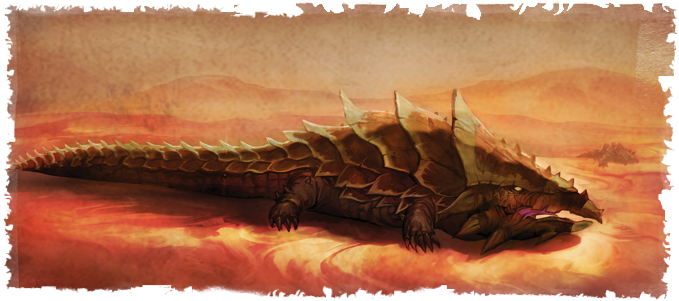
A Duneripper, displayed full length. Despite its stubby legs, this beast is shockingly quick.
|
The Giant Scorpion of the Deep Desert
|
Farther into the indescribable heat we go. I kept to the middle of the procession, and with good reason. From over a dune, I spotted an immense scuttling creature race down to the desert floor. An old man of the Ash'abah who was wandering away from the group parried valiantly but was seized by the fiend's giant claws before a horrible skewering took place. The Ash'abah huntsmen immediately tracked the colossal scorpion and surrounded it with shields aloft, and one brave soul leaped for the tail, incapacitating the beast before they set upon it with a flurry of blades. I sketched the fight for posterity. The old man may have died of his wounds, but we ate a palatable stew of scorpion meat that night.
T here have been tales of these giant, crablike beasts before the Redguards first explored the vast dunes of the Alik'r Desert. With only the duneripper to fear, the giant scorpion has been left alone to grow to enormous proportions. Its girth is comparable to a large bull, and it has two horrific front pincers, six smaller legs that end in sharp claws, and an immense and segmented prehensile tail, which would be a marvel to watch were it not the most feared natural weapon in Hammerfell. After one these monstrosities spots its prey, it moves with great speed across the sand, leaving only the shallowest of imprints.
It usually attacks with its claws, catching its meal before the tail lashes out, usually killing the poor victim quickly but unpleasantly: If the barbed stinger doesn't slay the victim outright, the deadly venom pumped into the open wound immobilizes it. The corpse or paralyzed victim is then slowly eaten and digested externally. To prevent this most heinous of deaths, it is recommended that you attack from behind, concentrating on incapacitating the tail, as the hardened carapace is extremely difficult to breach. Native shamans of the Ash'abah prize giant scorpion stingers, but they prefer to harvest these themselves, rather than pay for ones slain by others.
"Prehensile tail"?
"Digested externally"?
Fabricius is an idiot.
|
Not wishing to use the rudimentary latrines in the makeshift Ash'abah camp, which would require me to squat over a recently dug hole in the ground, I ventured into a nearby cave to relieve myself and apply some powder to my desert chafing. I found a suitable spot, finished my business, and felt the cool air on my cheeks. Buttoning up, I spotted the glow of torchlight deeper into the cave. Strange shadows darted about. Then I hear a wistful song. A lament in a language unknown to my ears. It was enchanting I edged forward, drawn like an ancestor moth to a Canticle tree.
I was forcefully halted by an Ash'abah named Barahar. She knew of the dangers of the Lamia and manhandled me away from that beautiful wail. Inserting dreugh wax into our ears, we returned to the cave, moving to an opening above the grotto below. Here, we watched, and I sketched, a Lamia on the prowl. I also drew speculative art of Lamiae that may lurk in jungles and swamps. I returned to the camp. Barahar emerged from the cave a while later, carrying the Lamia's skin over her shoulder and a vial of milked venom.
E xcitable children are subdued by talk of a Lamia visiting them in the night. Many variations of the tale exists where a charmed traveler surrenders to a terrible and painful death at the talons and bite of a Lamia. This beast is a well-known underwater menace to the fishermen of Daggerfall. Recent Imperial research, and evidence from local viziers in the Alik'r Desert region of Hammerfell, has discovered aggressive and untamed desert kin with a similar skeletal structure and vicious attack patterns.
The Lamia is an amalgam of snake and woman, although it is assumed they are hermaphroditic and lay eggs like a reptile (which are then abandoned and the immature Lamiae are left to fend for themselves). The less enlightened see this creature as a cursed people, but there is no evidence for this. Lamiae stand as tall as a full-grown Breton male when fully reared up, and they use their long tails to steady themselves while on land. Their sharp poison fangs, ophidian heads, and scaled tails have led to an aversion of this chimera cross Tamriel.
They have a lust for gold, jewels, and trinkets, and are known to loot and wear such treasure from the corpses of those they've slain. They understand language but have a rasping hiss rather than anything intelligible. However, they have developed an eerie, almost mesmerizing song that can entrance and entrap the credulous. They lack the intelligence to craft or make art, they never venture far from their lair, and they live independently unless they need to congregate for safety or are under the command of a more powerful Lamia or other entity. Their mastery of electrical magic is innate, not learned. But their appetite is voracious; they devour the flesh, meat, and bone of any living creature.
Beware the song of the Lamia. It may be the last lullaby you ever hear. Awful. That last line has got to go.
Oh, Fabricius. If they lay eggs, why do they have breasts? Fool.
|
|
A terrible revenant: the Wraith.
Note to self: not scary enough - repaint
|
In the silent dusk, we halted at the mausoleum on the outskirts of Bergama. The Ash'abah sat cross-legged, chanting in a circle while a warrior was washed with oils. "This is a purification ritual," Barahar whispered to me, "before our sword-adept banishes the angry ancestor-spirit." I began to understand: This was the Ash'abah's societal function -- dispatching the undead, as the majority of Redguards found it blasphemous to slay their own departed kin.
"Blade's edge!" The warrior took a long spear and walked into the mausoleum. A vast shape of cloaked air coalesced into a hooded form of skull and claw that tapered into nothing. Suddenly it let out an earsplitting howl, and frost magic danced toward the Redguards. The warrior adeptly evaded and spoke incomprehensible incantations. His spear glowed and he thrust it through the wraith's face.
An abrupt windstorm followed this departing phantom, but there would soon be a great deal more work for the Ash'abah.
T he dread mausoleums in the wastes near Bergama hold more than their fair share of the dead. Grave robbers tell of a terrible spectre, a hooded shape of fear, tattered and floating in the cool, stale air. Unlike a ghost, this wraith is a spirit without memory, raised from the dead or summoned by necromancy. They float, silent and thoughtless. But once you cross the threshold they are guarding, the magic that binds them quickens them into inflicting a savage, uncompromising attack.
|
How the Imperial scouts failed to find the thriving Redguard settlements within the desert interior boggles the mind. We've passed a surprising number of Redguards living in rudimentary villages. Naturally, the Ash'abah haven't been made welcome, but I did spent time sketching scenes from the primitive ways of life here, such as the inverted tentlike rain-catchers and the buried aqueducts for water collection. I sampled some cultivated succulents and passed a few goat herders. This place is teeming with life if you know where to look.
A Nightmare Land
By Knight Gallant Titianus Iulus, Watcher of Ska'vyn
F lat salt pans devoid of nourishment. Drifting wastes of sand. Sharp-clawed creatures and skeletal carcasses. Terrible horrors lurking above and below the sand. Sudden dust storms that choke and confuse. Water poisoned by the leaching salt. Knee-deep sand to slog through or impassable cliffs from which to plummet. Gorges that take days to circumvent. The deep desert of Alik'r is a nightmare land. It is this researcher's opinion that very few Redguards could survive for more than a few days out here. Surely people could live only in the coastal regions of Hammerfell, as the occupation of its interior has occurred through bluff, bluster, and the lack of any other race wanting this cursed and shriveled shell, a carbuncle on Tamriel's backside.
Titianus Iulus should be watching more than the community of Ska'vyn; his opinion is wildly inaccurate.
|
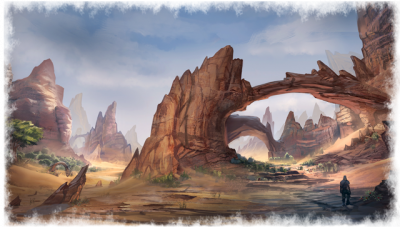 Ancient Elven ruins are occasionally found away from the coast. The Redguards plunder these for the deposits of Malachite ore.
I watched a miner crack open a geode node, exposed by the drifting sands. These are harvested for the gems and crystals inside.
At last I've had my fill of terrifying desert creatures, and I've been assured that the only jeopardy I'll face in the settlement of Bergama is the plundering of my coin purse. Apparently, the bartering of the market traders borders on extortion. In an almost comical display of social animosity, the Ash'abah have camped outside the town's walls behind a dune. This is so the residents of Bergama can pretend they aren't there. Ludicrous! Fortunately, I'm not seen as a pariah, so I've agreed to roam the town and purchase some supplies.
T he stately architecture of the Hammerfell interior varies from simple nomadic tents to the splendor of the sturdy domed structures within the city of Bergama. It is the latter we shall focus on in this chapter. Ask any Redguard worth his salt about the dwellings he retires to after a day's toil, and he'll proudly boast about their rigidity, flexibility, heat transference, and general ornate beauty. He's mostly right too; these foreigners have brought to Tamriel many interesting Yokudan advancements in construction that we should seek to imitate and perfect.
Speak to the Imperial stonemason who has rebuilt naves, walls, and crenelations after a raid on a Cyrodilic building, and he'll lament the difficulty in repairing such heavy and ornate stone. While much Imperial construction requires demolition and rebuilding after conflict, many of the Yokudan accent pieces, such as the flying staircases or ornamental domes, are designed to crumble after an attack or an earthquake; this allows them to be easily replaced in sections afterward. However, these structures are solid; they stand tall and firm despite the sweltering heat. But it doesn't take an architect to realize these structures reflect the original home of the Redguards.
"Designed to crumble", eh? I don't believe a word of it.
|
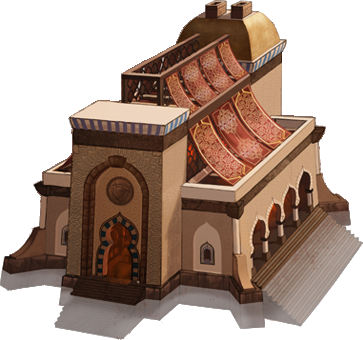 The many outer fortifications to this settlement are a sight to behold. The wall the defends Bergama is both ornate and substantial, with numerous foreign flourishes I've never witnessed before. While a Nord stable might be little more than a sturdy wooden barn, the Redguard stables are positively opulent but practical. The pavilion tent roofs can be retracted during a sandstorm and draped again to protect animals from the sun. All without compromising ventilation. Ingenious!
Before the bartering begins, my first priority is to locate an inn. The Ash'abah may abhor liquids more potent than tea, but I have no such qualms. In fact, I demand a sturdy cockle-warming after the frights of the last few days. I soon spotted an appropriate venue and chose an upper balcony. As I gazed through the slits in the tent roof at the night sky and the familiar glow of Masser and Secunda, I was brought an ewer of pomegranate wine. Sweet Mara, this is a sensational treat! In fact, I shall order another.
|
Bergama's Bustling Open-Air Market
|
After my wine, I placed a talisman to improve bartering around my neck and strode confidently into Bergama Market, still bustling after dark. Amid the bleats of goats, the shouts of robed outcriers, and the smell of meats and incense, I stopped first at a small blacksmith's stall to purchase additional weapons. Try as I might, I couldn't secure a bargain. I fared little better at the herbalist; the dried herbs, other roots, and reagent powder I gathered were twice the price compared to Wayrest! Even a deal on waterskins eluded me.
I didn't mind; not all my stipend was spent. So I wandered farther and enjoyed a furious barter session for a set of genuine Lamia-skin Tu'whacca prayer wheels (these aren't some Argonian imitations, I was told). I also had to have a set of magic duneripper spine dowsing sticks. The trader made me a "water-tight guarantee!" Oh, how we laughed at his joke. Then I noticed a lady selling large skins of pomegranate wine. Still jovial from my last supping, I became eager for this, the most delicious of beverages. I may, perhaps, have overpaid.
Oh, what an impetuous fool I am. I corked the wine the moment I realized I'd actually been wearing an amulet that aided in seawalking. This had improved my posture but weakened my bartering considerably. That, and my tipsiness, meant I'd been nefariously plucked of all my coin by the time I stumbled into some genuine cultured treasures. All I could do was sit and sketch, passing up the intricately knotted goat-hair rugs, inlaid and gilded urns and lanterns, and the exquisite furniture. I regretted frittering away all the Ash'abah's funds too. Then one of the dowsing sticks punctured my wineskin, staining a costly bolt of silk. I quietly made my exit before the silk merchant noticed the damage.
|
The Great Mortuary Shrine of Tu'whacca's Throne
|
I explained away my drunken bartering to the Ash'abah, telling them the recent turmoil in Tamriel caused prices to soar, and we set off at dawn to make for Tu'whacca's Throne. Barahar informed me the tribe was duty-bound to visit there to perform the annual Rite of Royal Rest, which seals the Redguard kings and queens into their tombs and keeps them happy in the afterlife so they aren't tempted to return and rule from beyond death. At least, that was the theory.
Tu'whacca's Throne is more than a simple sepulcher; it is a terrifyingly vast monument to the dead. No wonder the ritual is important-there are enough buried dead to summon a city's population of undead! As the Throne Keepers retired from the ruins for the 36 hours the rite took, I was stopped at the entrance, a sack was placed over my head, and I was left to meditate in a goat pen. Apparently such rituals are not for the eyes of an outsider. Despite the smell of dung, I was content to wait. I'd been having flashes of memories from the last time I was in a mausoleum, and my chest brand itched in unison.
Reverence of the Dead: Tu'whacca and Burial Rites in Contemporary Redguard Culture
by Brother Opilio Congonius
T he Redguards revere their departed ancestors so fervidly that it rivals the devotion many other races have for their gods. While a Breton may place a casket in ornately arched consecrated ground, or a Nord may place a wind-dried body on a shelf in a burial vault, the Redguards design and erect vast funerary structures for their dead that are as awe-inspiring as they are extensive. The thread of honor that binds the Redguards from before birth to beyond death is strong. These soaring and massive mausoleums are the purest representations of the undiluted Yokudan architecture, built to propel spirits to a meeting with their putative gods.
Perhaps the finest example of this type of burial site is Tu'whacca's Throne, set atop a vast plateau in the Alik'r Desert of Hammerfell. This huge temple is dedicated to the Tricky God, the Shepherd of Souls, and the Caretaker of the Far Shores. After ascending from the desert grazing fields, up the stone stairs carved into the plateau's side, one is first struck by the incredible views from atop this flat expanse of rock and sand. After passing the Throne Keepers, who are ever vigilant and maintain Tu'whacca's Throne, the eyes meet the true majesty of this sacred place.
This necropolis is both a sprawling burial ground and a sacred ruin. Aside from Tu'whacca's presence watching from dark corners of this sanctuary, the temple also serves as a monument to the untold number of Yokudans who perished when the continent sank beneath the waves. Pilgrims travel across the stinging sands to pay their respects to these victims and to the historical Redguard kings who are also interred in this labyrinthine necropolis.
|
|
Yokudan Funerary Structures
|
I must admit the wine made me emboldened enough to remove my blindfold. Blinking at the necropolis entrance, I noticed the area was empty, so I stepped through and began sketching the columns and crenelations. After filling my page with fine art, I took a stroll and found myself gazing up at a mausoleum. It was guarded by the statues of two kings with their arms raised in warning. But the doorway was slightly open. Inquisitiveness won the day, and I crept over the threshold. I was immediately met by a void of blackness.
I tiptoed forward, my nostrils twitching in the stagnant air. Then I stopped, feeling a sudden chill through my bones. A great, cold hand fell onto my shoulder and began to squeeze. I let out a silent shout of terror, rummaged through my satchel, grabbed my genuine Tu'whacca prayer wheel, and walloped this unseen assailant. Fleeing in abject terror, I made for the slit of daylight, past the two kings, and back to the goat pen. A swift look over my shoulder magnified my fears. Something had followed me out. Something wreathed in darkness. An indistinct figure that refused to be seen properly.
I had made an error in judgment.
The Ash'abah raced from the temple, their trackers following the rage of dark chaos that had stalked off at some speed and seemed intent on heading toward the nearby settlement of Leki's Blade. Chief Marimah turned to me. "You are a walking disaster, aren't you? Have you been sent here to test us?" I started an apology but trailed off as a blade was pointed my way. "You have roused the spirit of Ra Boshek, the evil usurper-king. Killing you would only add to my anger. Follow me." Sheogorath was smiling on us today.
The only comfort in this maelstrom of fury and confusion was that the liberated mummy was using an ancient trader's trail, and the Ash'abah knew a shorter path to the township. After a lung-bursting march over dunes, with the blowing wind the only sound over faint muttering (I heard my name associated with some very improper guttural language), we spotted the sword statue for which the settlement was named. The Ash'abah were already herding the local Redguards into a defensible hilltop tower.
Marimah was being prepared by his priests for combat with the revenant. Barahar pushed past the huddled villagers and fired barbed words at me: "This ritual requires the sacrifice of four white sheep." She held out her hand for payment. I offered her one of my genuine prayer wheels and she spat on the ground at my feet. I gave her a gold ring and waited for the skirmish to commence. My guilt was immeasurable.
T he desert outpost of Leki's Blade was built in the First Era around the shrine of the same name. Hewn from local materials, the huge statue of the gripped sword still serves as a navigational point, an idol and marker for the Redguards to witness on the pilgrimage to this place. Local scholars may argue over certain details, but it is certain that Leki's Shrine was established by the last of the Ansei as a training temple, where their sword knowledge could be passed down to later generations. Today, Redguards travel from the four corners of Hammerfell to study under the broken blade.
From the young child who learns focus with a blade, to the adult warrior who seeks further prowess and meditation, to the master who yearns for final instructions, all seek tutelage here. Local myth claims that the spirits of the departed Ansei watch over the hearts and desires of those training in this temple. The Ansei, known as sword-singers, recruited members to their order at age 11, and males became known as "Brothers of the Blade" while females earned the title "Maidens of the Spirit Sword." The most famous Ansei is Frandar Hunding (whose life and tribulations can be found in Appendix 13).
|
Marimah triumphed over the revenant. Priests rushed to assess his wounds. He waved them off and stepped over the steaming husks of linen, still twitching and strewn across the sand. I honestly though I was joining Ra Boshek in a cursed afterlife, but Marimah beckoned me over to Leki's Shrine and rinsed his sweating face. Wiping his brow, he calmly remarked, "You have had unsanctified contact with Ra Boshek. You are unfit to consort further with us." Moments later, the Ash'abah gathered the remains of the revenant and disappeared from Leki's Blade.
I halfheartedly drew some ceremonial plaques and the shrine's altar before sheepishly hiring a guide to take me to the coast and from there a ferry to Evermore. "A pariah from the pariah tribe! An exile from the exiles!" I half smiled at Jad, the coachman, and requested no further conversation from his mouth.
Later, my brand turned hot as I shrieked myself awake from a nightmare. I saw a vision of worms, writhing from the eye sockets in a corpse's head. They chewed through the mouth as the corpse shook violently and burst apart, and Mannimarco himself stepped into view. He thrust his arm through my brand, into my chest, and squeezed. I writhed in agony.
After a short bout of weeping, I found myself at the port and pulled myself together. I invested in one last skin of pomegranate wine, boarded the ferry gangplank, and vowed never to return here.
|

